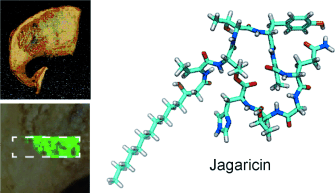Bacterial virulence factor of mushroom soft rot identified

(Phys.org)—Soft rot diseases cause a great deal of damage in agriculture, and turn fruits, vegetables, and mushrooms to mush. By using imaging mass spectrometry together with genetic and bioinformatic techniques (genome mining), German researchers have now discovered the substance the bacteria use to decompose mushrooms. As the scientists report in the journal Angewandte Chemie, the substance called jagaricin could represent a starting point for the development of new antifungal drugs.
Button mushrooms with soft rot develop typical lesions and are eventually completely disintegrate. The pathogen causing soft rot in cultivated mushrooms has been identified as Janthinobacterium agarididamnosum. A team led by Christian Hertweck at the Leibniz Institute for Natural Product Research and Infection Biology in Jena (Germany) wanted to know which bacterial compound is responsible for this destruction in order to better understand the pathobiology and to find possible protective measures. If the soft rot bacteria produce a substance that attacks mushrooms, it is also conceivable that this substance could be effective against microbial fungi, which cause dangerous infections in humans.
Their challenge was to search for an unknown substance that the bacteria do not produce under standard culture conditions, but only when they attack a mushroom. Hertweck and his co-workers used a method called genome mining. They sequenced the genome of the bacterium and searched it for relevant biosynthesis genes. Using bioinformatic techniques, they made predictions about the structures of the metabolites. In order to stimulate the production of virulence factors, the researchers infected slices of button mushroom with the bacterium and examined the resulting decomposed areas with imaging mass spectrometry. This produced a mass spectrum for every point measured on the analyzed surface, allowing the researchers to identify a mass peak that only occurred in spectra from infected areas. The team found a DNA jag sequence that codes for the biosynthetic apparatus that produces the substance in question. Addition of mushroom fragments and a special growth medium then allowed them to obtain and isolate larger amounts of the compound from a liquid cell culture.
The structure of jagaricin – which is what they called the substance – was fully determined using physical chemical analyses, chemical derivatization, and bioinformatics. The compound is a novel lipopeptide with an unusual structure. Pure jagaricin induces the symptoms of soft rot in mushrooms. The researchers were thus able to demonstrate that jagaricin is involved in the infectious process of the soft rot disease. Degrading enzymes presumably also participate.
The scientists also determined that jagaricin is effective against Candida albicans, Aspergillus fumigatus, and Aspergillus terreus, which cause human fungal infections. Perhaps this substance could be a starting point for the development of a new antifungal drug.
More information: Hertweck, C. Imaging Mass Spectrometry and Genome Mining Reveal Highly Antifungal Virulence Factor of Mushroom Soft Rot Pathogen, Angewandte Chemie International Edition. dx.doi.org/10.1002/anie.201206658
Journal information: Angewandte Chemie , Angewandte Chemie International Edition
Provided by Angewandte Chemie















